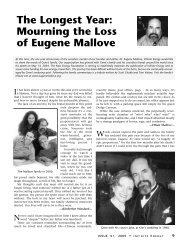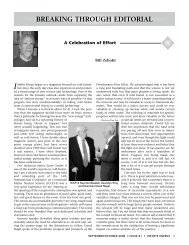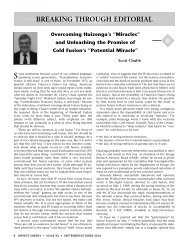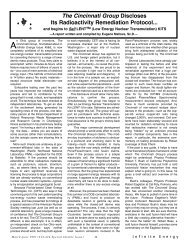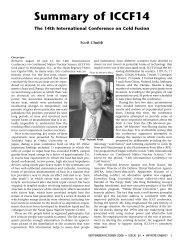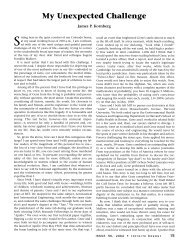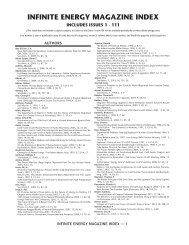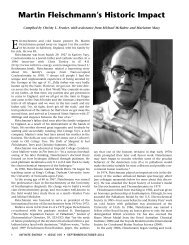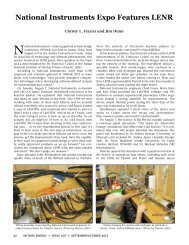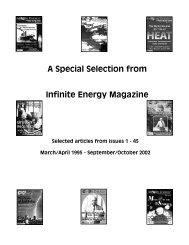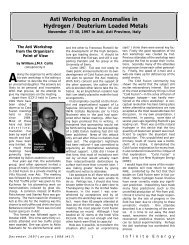MIT and Cold Fusion: A Special Report - Infinite Energy Magazine
MIT and Cold Fusion: A Special Report - Infinite Energy Magazine
MIT and Cold Fusion: A Special Report - Infinite Energy Magazine
You also want an ePaper? Increase the reach of your titles
YUMPU automatically turns print PDFs into web optimized ePapers that Google loves.
A lecture by cold fusion theorist Nobel<br />
Laureate Julian Schwinger, November 11, 1991, at<br />
<strong>MIT</strong> celebrating the 60th birthday of<br />
Professor Kenneth Johnson—a former student<br />
In Nobel Laureate Julian Schwinger’s eloquent talk at <strong>MIT</strong>, he<br />
compared the possible theoretical foundation of cold fusion with<br />
that of the much more accepted but equally mysterious phenomenon,<br />
sonoluminescence. Julian Schwinger had resigned from<br />
the American Physical Society (APS) to protest its censorship of<br />
his theoretical work on cold fusion from APS publications. It was<br />
an honor for me to have become a good friend of Schwinger’s<br />
due to my involvement with cold fusion. His praise for my book,<br />
Fire from Ice, was a very great honor (see prior page). Unfortunately,<br />
Schwinger’s 1991 message at <strong>MIT</strong> was not absorbed by<br />
the assembled <strong>MIT</strong> physicists.—EFM<br />
A Progress <strong>Report</strong>:<br />
<strong>Energy</strong> Transfer in <strong>Cold</strong> <strong>Fusion</strong><br />
<strong>and</strong> Sonoluminescence<br />
by Julian Schwinger, University of California<br />
Birthday celebrations are inevitably somewhat nostalgic.<br />
Appropriately, then, I found the cover title for this lecture in my<br />
own distant past. I first came to Berkeley on the day that World<br />
War II began. Not long after, Robert Oppenheimer gave a lecture—perhaps<br />
on cosmic ray physics—which he called “A<br />
Progress <strong>Report</strong>,” in the sense, he explained, that time had<br />
elapsed. A similar expression of modesty is in order here. I have<br />
no great discoveries to announce; only feelings, hypotheses,<br />
<strong>and</strong> programs. As Mort Sahl once<br />
proclaimed:<br />
The future lies ahead.<br />
—sanity, I submit, is not a canon of science.<br />
Indeed, isn’t it a goal of physics,<br />
specifically, to push at the frontiers of<br />
accepted theory through suitably<br />
designed experiments, not only to<br />
extend those frontiers, but, more importantly,<br />
to find fundamental flaws that<br />
dem<strong>and</strong> the introduction of new <strong>and</strong><br />
revolutionary physics?<br />
19 <strong>Infinite</strong> <strong>Energy</strong> • ISSUE 24, 1999 • <strong>MIT</strong> <strong>Special</strong> <strong>Report</strong><br />
I am sure that my first topic,<br />
cold fusion, has caused many eyebrows<br />
to levitate. <strong>Cold</strong> fusion?<br />
Isn’t all that nonsense dead <strong>and</strong><br />
buried? How can anyone be so<br />
insane as to talk about this totally<br />
discredited subject?<br />
Well, to the extent that sanity<br />
implies conformity with the mores<br />
of a society—didn't the Soviets<br />
clap their egregious dissidents<br />
into insane asylums?—sanity, I<br />
submit, is not a canon of science.<br />
Indeed, isn’t it a goal of physics, specifically, to push at the frontiers<br />
of accepted theory through suitably designed experiments,<br />
not only to extend those frontiers, but, more importantly, to find<br />
fundamental flaws that dem<strong>and</strong> the introduction of new <strong>and</strong><br />
revolutionary physics?<br />
The seemingly bizarre behavior of some key players in the<br />
cold fusion melodrama has managed to obscure a fundamental<br />
challenge that this episode presents. Whether or not the reality<br />
of cold fusion has been demonstrated experimentally, one must<br />
ask if any conceivable mechanism now exists, or might be<br />
devised, whereby nuclear energy could be extracted by manipulations<br />
at the atomic level.<br />
One is mindful of the high temperature superconductivity<br />
story. Despite the assurances of theorists that superconductivity<br />
could not exist much above absolute zero, that barrier was<br />
broken experimentally. Although it took time to get reproducible<br />
results, the reality of the phenomenon is completely<br />
established, despite the absence (to my knowledge) of any<br />
accepted theory.<br />
High temperature superconductivity<br />
is an atomic process.<br />
<strong>Cold</strong> fusion is that too, but also<br />
involves the much shorter space<br />
<strong>and</strong> time scales of nuclear<br />
physics. It should therefore be<br />
much more difficult to control<br />
this phenomenon by manipulations<br />
at the atomic, perhaps better<br />
said: at the chemical, level.<br />
More difficult, but not necessarily<br />
impossible.<br />
Despite my earlier qualification<br />
of the established reality of<br />
cold fusion, one cannot ignore<br />
the evidence accumulated in<br />
many laboratories—of excess heat production, of tritium production—all<br />
of which is characterized by irreproducibility <strong>and</strong><br />
by uncontrollable emission in bursts. But, from what has just<br />
been said, that kind of behavior is expected; it is not a basis for<br />
rejecting the reality of the phenomena.<br />
This brings me to study the validity of the case against cold<br />
fusion, as seen by a hot fusioneer—henceforth known as HF—<br />
who rejects the possibility that new physics is involved.<br />
In the hot fusion of two deuterons—the D-D reaction—the<br />
formation of a triton ( 3 H) <strong>and</strong> a proton proceeds at about the<br />
same rate as that for the creation of 3 He <strong>and</strong> a neutron. But,<br />
given the claims of tritium production in cold fusion experiments,<br />
neutrons at the expected intensities are conspicuously<br />
absent, although low levels of neutrons, appearing in bursts,<br />
have been observed. To HF the conclusion is obvious: No neu-



